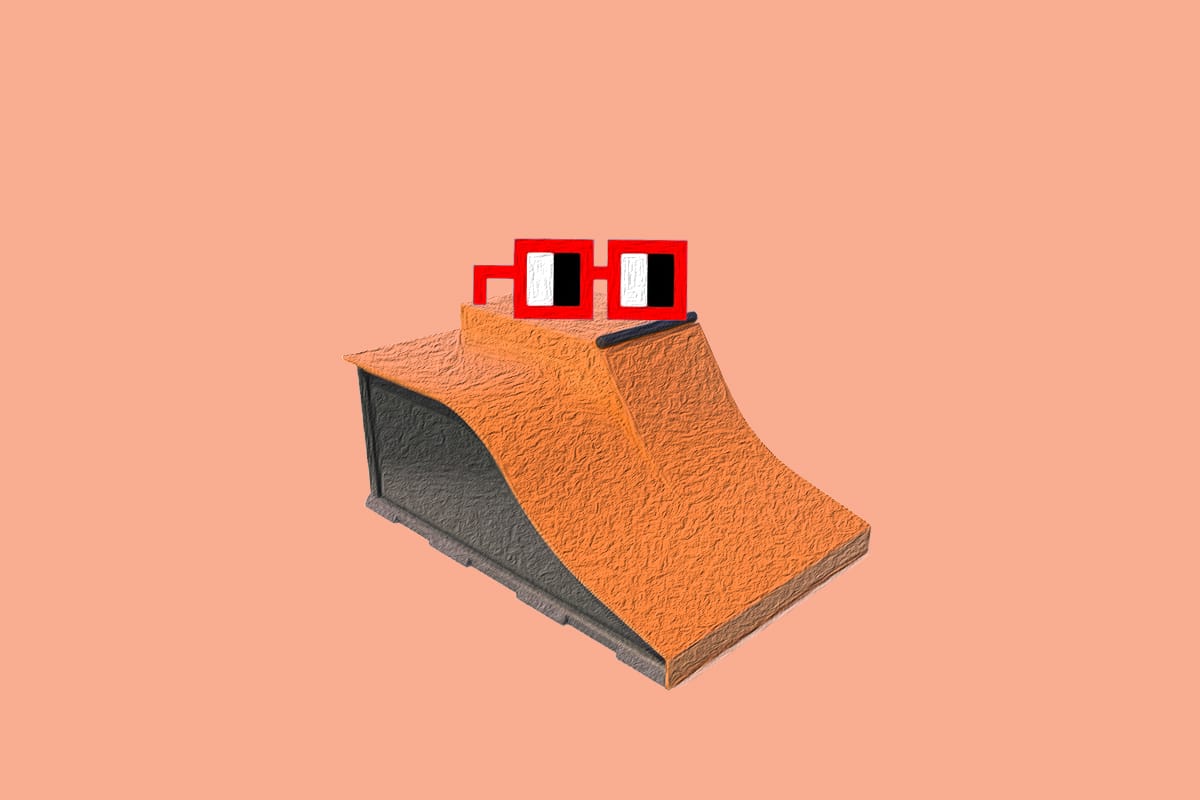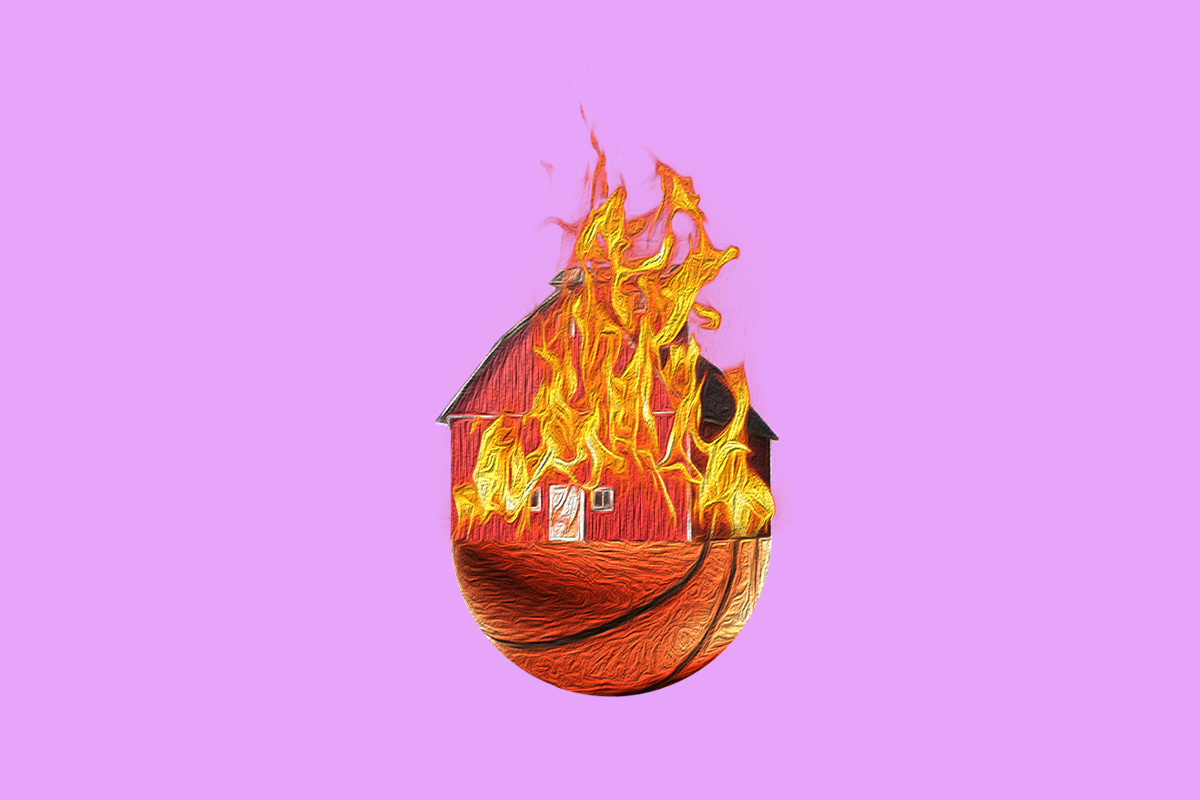The pioneering vision of ⌐◨-◨
Plus: Kasso is back, an RDS tour video(?), Alex Willms and the reality behind our entertainment, New Balance Numeric's "Intervals" is coming, and more.

The definitive weekly ranking and analysis of all the skateboarding and other things online that I cannot stop consuming and how it makes me feel, personally.

Silly is in high demand
Rank: 1
Mood: 🎢
It isn't a zero-sum game by any means, but it also wouldn't be unfair to note that the most entertaining and talked-about skateboarding competitions are the ones that are silly as hell. I don't imagine that's a marginal opinion, either. From the success of Dime's Glory Challenge to The Bunt Jam, people want silly. Silly is in such high demand that The Bunt is even exporting its Jam to Melbourne, Australia, in November.

You could argue that skateboarding's overly serious "Get Tricks Or Die Trying" phase of the aughts and 2010s had people craving relief in the form of silly when the Glory Challenge came on the scene in 2015, but skateboarding has always been silly, even if the silly was cloistered into pockets of Tilt Mode and Enjoi. I think the easier explanation is that while watching, say, an Olympic qualifying event is entertaining, it's just more fun to watch Leo Romero try and grind some fucked up rail suspended over a pool of water on a Japanese reality show.
All this to say that Kasso, the absurd skateboarding obstacle course series, is back. I wrote about Kasso and its mastermind, the YouTuber MDAskater, in more detail in April as their first episodes began to take off. They must have done well for their broadcast and production partner TBS (Tokyo Broadcasting Station), as just the first episode of the new batch (which streamed on the Kasso YouTube page for 24 hours but has since been taken down, one assumes, in anticipation of its next episode on October 22) is a clear step up, from the increasingly extreme courses to having the budget to bring in big-name American and European PROs like Romero, Wes Kremer, and Madars Apse.
While the reality show production quirks can be a bit grating at times, and giving the incredible Yurin Fujii the on-screen nickname "the fearless skater chick" is an eyebrow-raiser, overall, Kasso is the perfect treat for those who want their skateboarding competitions to be downright stupid, in the best of ways. Bless them.
Speaking of, the 2024 Quartersnacks Cup took place over the weekend, which featured some of the skateboarding industry's biggest stars competing against one another... in a race. Let silly reign.

The pioneering vision of ⌐◨-◨
Rank: ...
Mood: 🕶️
It's okay to not understand or care about the following few paragraphs. In fact, it's probably best that we, as a collective skateboarding community, forget them as soon as we read them — a burn-after-reading sort of agreement.
Last weekend, one of professional skateboarding's greats, Bob Burnquist, hosted an NFT-themed festival called NOUNS CAN DREAM: The Art of Skateboarding at his house/private skatepark compound. "Nouns," or "Nouns DAO" (decentralized autonomous organization), is ostensibly an NFT project. Their whole schtick appears to be selling automatically-generated pixelated avatars that wear glasses, which they call "Noggles," to fund other projects like "creating Nouns short films, to distributing eyeglasses to kids, to partnering with Bud Light for a Super Bowl commercial in 2022," per Molly White at Web 3 is Going Just Great. Their website describes their mission as thus:
Nouns are an experimental attempt to improve the formation of on-chain avatar communities. While projects such as CryptoPunks have attempted to bootstrap digital community and identity, Nouns attempt to bootstrap identity, community, governance, and a treasury that can be used by the community.
Okay.
The "NOUNS CAN DREAM" YouTube livestream video description hails the event as "a unique celebration that invites the Nouns community, skateboarders, artists, and on-chain enthusiasts out a day [sic] of creativity, fun, and innovation. Hosted at Dreamland, the legendary skateboarding haven created by Bob Burnquist, this event promises to be a fusion of skateboarding culture, artistic expression, and the pioneering vision of ⌐◨-◨ ."
Regular readers of Simple Magic are likely familiar with Burnquist's genuine passion for... the blockchain. He's fronted projects, he's sung the gospel of NFTs to the mayor of Sãu Paulo, and now, he's got Noggles on his Mega Ramp.

Personally, I don't want to think about this for any longer than I have to. If these "Nouns" mean something in the grand scheme, I would prefer not to be privy to such a scheme — because, frankly, that's what all of this appears to be. It's upsetting that I now know what a Noggle is and that a whole community has invested so much time, energy, and money into the belief that this is anything but a scam. They seem to be having fun, though. So that's something, I guess.

Ah, well. Now, what were we talking about?

Sure, this is what we're talking about
Rank: ...1?
Mood: ✌️🀄✌️
The longstanding Canadian apparel brand Red Dragon Society, otherwise known as RDS, sent its longtime team riders, Ryan Decenzo and Micky Papa, to Shanghai, China. And you know what? Those guys put it down. There are tricks in the subsequent sub-five-minute tour video chronicling the trip that I'm astonished weren't saved for a different, bigger project. It's even more shocking how much high-quality footage Decenzo and Papa accumulated in "a week or so."
The video is also a textbook, if stereotypical example of the cultural morass that Canadian skateboarding found itself in for years, where many top-level skateboarders and pieces of skateboarding media were often overlooked and underappreciated due to their distance from the industry power centre of California and, most importantly, a distinct lack of taste. From the country's tall-tee epidemic of the 2000s to the stylistically abrasive efforts like... any RDS video, that wound was mostly self-inflicted and the scar still burns bright.
In A Week Or So In... Shanghai, we fall back into that familiar territory. As someone who grew up on these kinds of videos, it's almost comforting to watch a contemporary edit with amazing skateboarding performed by skateboarders with negative style, hokey yet serious cross-dissolve transitions, and a brooding, uninspired instrumental soundtrack that would fit in seamlessly on the b-side of a Swollen Members record. The sound levels are also off, with the audio capture of the skateboarding itself set much too low, and there is often gunk on the fish-eye lens. It reminds me of something I'd put together with my friends in 2005 — minus the professional-grade skateboarding — which has a certain charm.
Dime, for the betterment of the country, usurped RDS' status as its most well-known brand almost a decade ago. This development encouraged new generations of Canadian skateboarders to escape the shadow of the tall tee and experiment aesthetically and on the board, even if the career options in an ailing industry have dwindled to scraps. To that end, it is surprising that RDS still does well enough financially to send a crew to China and take out two-page ads in Thrasher. Perhaps we should be grateful that this last vestige of Canadian skateboarding from that era manages to survive, if not in genuine appreciation, then for the fact that Decenzo and Papa are getting paid.

The reality behind our entertainment
Rank: N/A
Mood: N/A
Skateboarding is dangerous, that much is obvious. While any wayward fall can cause serious injury, for the most part, it's a manageable risk for the everyday practitioner. Professional skateboarding, the career path that requires a person to, depending on their style of skateboarding, continually put themselves in harm's way in an effort to accumulate photos and video clips for use in promotional materials for brands, is something else entirely.
The vast majority of those "careers" amount to a few hundred or thousand dollars per month that come in from a collection of sponsors, and those opportunities are often cut short by injury. That is the reality of the job. Sponsored skateboarders are also independent contractors, which means there are no pensions or labour protections, and most professional and amateur skateboarders, especially in the United States, don't have health insurance or access to regular medical care to take care of the regular, if we're to be accurate, workplace injuries they suffer.
Often, those injuries become part of their sponsor's marketing materials, as I wrote last year about the promotion of Pedro Delfino's solo effort, Road to Nowhere.
Given how raw and violent Delfino’s skating can be, especially in this recent video part that begins with him taking a disturbing and concussive slam, you can see the promotional reasoning behind giving away a t-shirt with Delfino’s bloody and swollen face on it. However, celebrating another instance of Delfino knocking himself out cold does feel a bit strange.
Over the years and across video parts, we’ve watched him turn his lights out multiple times in an increasingly troubling fashion. Of course, there is an inherent risk to skateboarding, especially at the level of Delfino, and one has to be prepared to accept the consequences as much as the rewards, but do we need to glorify brain trauma in this way? Just one slam of that nature can change the trajectory of a person’s life, with its impact not apparent until years down the line.
While his courage is admirable, seeing slams of that magnitude makes you question what we’re doing here. What he does on his skateboard is ultimately his choice, but is taking damage like this worth it for our entertainment? To advance the sport? For the promotion of a brand? To build a career that, in all likelihood, won’t set you up for the future financially?
The old “skate or die” ethos that had permeated the culture for decades still hangs around like an unruly ghost, and in brutal cases like this, the true “hellride” might not be the oft-hyped devil-may-care attitude or death-defying stunts, but what life looks like after the skateboarding is done.
Over the weekend, SK8MAFIA standout Alex Willms shared in detail via Instagram the turn his life has taken after taking a severe slam last year.
18 months ago I had a Traumatic Brain Injury that has taken me out. After life-changing head injuries in 2004 and 2018, this last one in 2023 pushed me over the edge. After the impact, I developed Persistent Post Concussion Syndrome and Postural Orthostatic Tachycardia Syndrome.
I have been experiencing drawn out symptoms from the accumulation of several head blows for longer than I knew. Most of them were always mental. After my 2023 injury I developed new symptoms that began affecting me physically. The intensity of these symptoms goes up and down, but they are present every day.
While I can skate some days for short periods early in the day, things aren't the same. The prognosis is indefinite.
That is scary and sobering. Credit to Willms for his candidness. It cannot be easy to face a future that may no longer include the thing you've spent your life doing, not to mention the uncertainty that remains off the board. Will it stop others from taking similar risks or get them to wear a helmet? Unlikely. Those risks are a part of the appeal for some. It's why they are still glorified in brands' marketing and in the culture at large. Hopefully, Willms' story and his sharing of educational resources around TBIs, like the efforts of the late James Hardy, whose brain trauma ultimately caused his death earlier this year, will open more eyes inside the industry and out so those who may be suffering can understand what's happening and get help.
Willms' current condition and Hardy's untimely death are the reality of the skateboarding we take in as entertainment. The costs can be high for those we watch. Most professional skateboarders are barely getting paid enough to survive and certainly not enough to retire. For the fortunate, it may give them the opportunity to travel the world and etch their name into our shared history. The unfortunate may not be able to remember that history at all.
If professional skateboarding can't give people financial security, those seeking that life should, at the very least, be taught what it can take from them.

Serious business
Rank: 3
Mood: 🔱
I've said it before and I'll say it again: there's nothing like a good skate video trailer. As we continue slogging through this digital era where endless streams of content find us in whatever direction we turn and in whichever screen we happen to be looking at, it's nice to have anticipation build for something and not have it enter and exit our line of sight without much thought toward it in either direction.
In the case of New Balance Numeric's upcoming video Intervals they've given us a highly polished teaser to chew on ahead of its online release in November. The trailer certainly does its job of hyping up the project, but from what we're shown, it also, I fear, veers into the realm of a late-career Ty Evans in its self-seriousness. There is the pounding, dramatic song choice, the stylized hero shots of its stars, and a few angles that capture the skateboarding as if it were a GoPro commercial.
That comparison is also apparent to the video's star. In his interview from the latest issue of Thrasher, Jamie Foy, who starred in Ty Evans' ludicrously-titled The Flat Earth, says that the filming techniques in Intervals "reminds me more of the stuff I used to do with Ty [Evans] when he was doing it. It's a little more cinematic. But it's really cool... They're gettin' a little high-tech with it."
That doesn't inspire confidence in those like myself who struggle to connect with that style of work, but I'm still excited, regardless. Kyle Camarillo has a solid track record as a filmmaker and there are just too many intriguing storylines in Intervals not to be. This will be Foy's fourth major video part of the year and expectations are high. On top of that, we're getting a new Tiago Lemos part, with unconfirmed chatter online that another could be on the way. And, of course, we get to see Brandon Westgate, one of professional skateboarding's best yet oft-forgotten names.
Intervals has all the potential to be one of the year's best offerings, and if the reactions from those at the premiere last night in Los Angeles are any indication, it fulfills that promise. And if not that, it will look great played on mute in the background of skate shops everywhere.

Something to consider: How goddamn good Chloe Covell is getting.

Good thing:

Another good thing:
A good second annual thing:

Farewell to a legend: RIP Patti McGee.

Until next week… if your hotel has a skate spot outside of it and you stop to check it out from all angles, take photos, and run up and down it as if you were skating, the hotel staff might give you odd looks. This is fine. Your stay comes with a complimentary spot check.



Laser Quit Smoking Massage
NEWEST PRESS
--------------------------------
My new collection of essays is available now. I think you might like it. The Edmonton Journal thinks it's a "local book set to make a mark in 2024." The CBC called it "quirky yet insightful." lol.
Book cover by Hiller Goodspeed.

Right, Down + Circle
ECW PRESS
--------------------------------
I wrote a book about the history and cultural impact of Tony Hawk’s Pro Skater that you can find at your local bookshop or order online now. I think you might like this one, too.
Here’s what Michael Christie, Giller Prize-nominated author of the novels Greenwood and If I Fall, If I Die, had to say about the thing.
“With incisive and heartfelt writing, Cole Nowicki unlocks the source code of the massively influential cultural phenomenon that is Tony Hawk’s Pro Skater, and finds wonderful Easter-eggs of meaning within. Even non-skaters will be wowed by this examination of youth, community, risk, and authenticity and gain a new appreciation of skateboarding’s massive influence upon our larger culture. This is my new favorite book about skateboarding, which isn’t really about skateboarding — it’s about everything.”
Photo via The Palomino.









